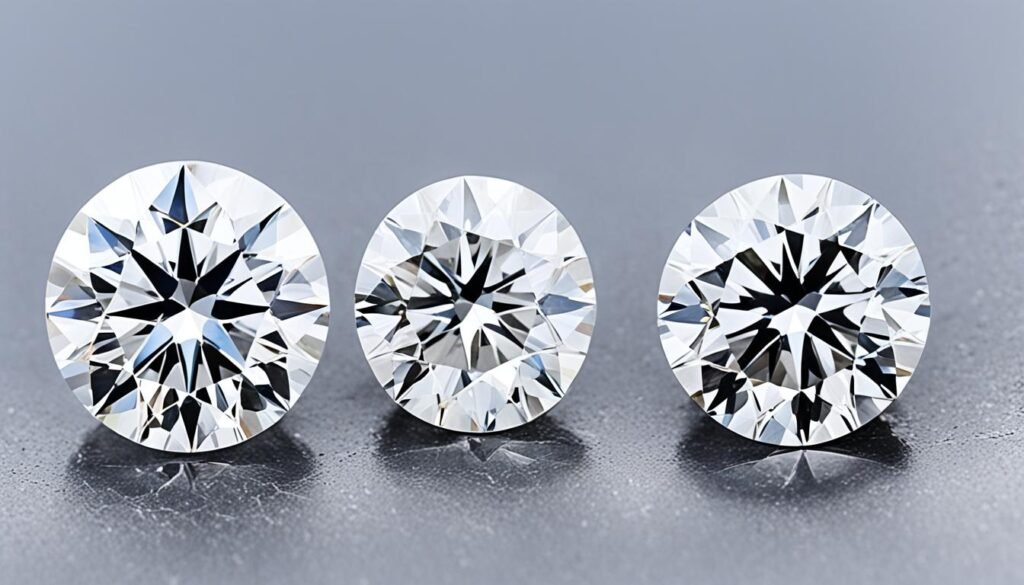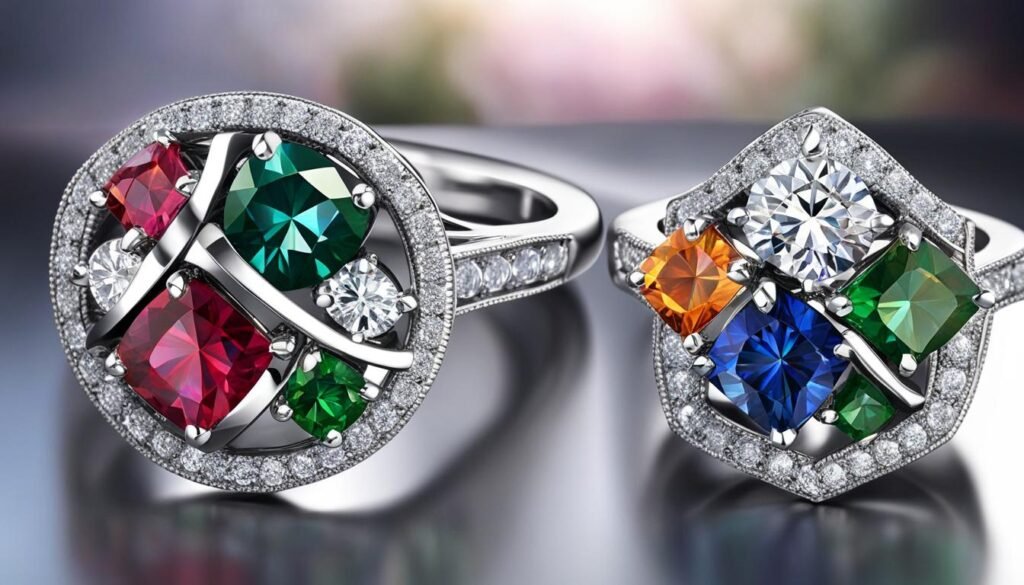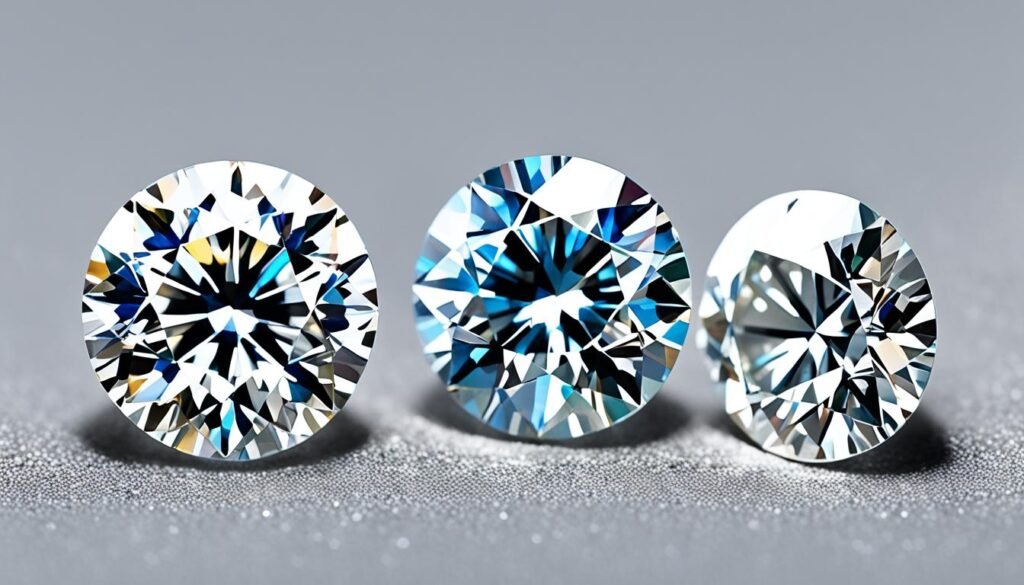When it comes to choosing an engagement ring, the decision between moissanite and diamond can be difficult. Both gemstones have their own unique qualities and characteristics that make them appealing to different individuals. This article aims to provide a comprehensive comparison of moissanite and diamonds, outlining the key differences and benefits of each option.
Moissanite is a lab-created mineral called silicon carbide, while diamonds are naturally occurring. While diamonds have long been the traditional choice for engagement rings, moissanite has gained popularity due to its affordability and stunning brilliance.
Let’s delve deeper into the comparison between moissanite and diamonds, considering factors such as price, brilliance, durability, resale value, and more.
Key Takeaways:
- Moissanite is a lab-created mineral, while diamonds are naturally occurring.
- Moissanite is considerably cheaper than diamonds, making it a more budget-friendly choice.
- Diamonds are known for their durability and hardness, ranking a 10 on the Mohs scale, while moissanite ranks slightly below.
- Moissanite has more sparkle and fire than diamonds, making it incredibly eye-catching.
- Moissanite offers a more affordable price point and larger sizes compared to diamonds.
Moissanite Price vs Diamond Price
One of the biggest advantages of choosing moissanite over a diamond is the price. Moissanite stones are significantly cheaper than diamonds of the same size and quality. In fact, a moissanite gem is approximately one-tenth the cost of a mined diamond of equal size and quality. This price difference becomes more significant with larger carat weights. So, if you’re looking for a large-carat white gemstone but don’t have the budget for a diamond, moissanite is a more affordable option.
Lower quality, smaller diamonds tend to cost more than higher quality, larger moissanite stones. When it comes to price, moissanite is a clear winner.
Price Comparison: Moissanite vs Diamond
| Gemstone | Size (in carats) | Price Range |
|---|---|---|
| Moissanite | 1 carat | $500 – $1,000 |
| Diamond | 1 carat | $3,000 – $6,000 |
| 2 carats | $10,000 – $20,000 |
As seen in the table above, moissanite offers a significant cost advantage compared to diamonds. You can get a 1-carat moissanite for as low as $500, whereas a diamond of the same size would cost between $3,000 and $6,000. Even with larger carat weights, moissanite remains a more affordable option. Keep in mind that these prices are approximate and can vary depending on factors such as quality and retailer.
“Choosing moissanite allows you to have a stunning, high-quality gemstone without breaking the bank.” – Jewelry Expert
Whether you’re working with a tight budget or simply looking for the best value for your money, moissanite offers a cost-effective alternative to diamonds. By opting for moissanite, you can save a significant amount while still enjoying the beauty and elegance of a sparkling gemstone.
Moissanite Durability vs Diamond Durability
When it comes to choosing an engagement ring stone, durability is a vital consideration. Diamonds have long been celebrated for their exceptional durability and hardness, scoring a perfect 10 on the Mohs scale. They can withstand various forms of wear and tear, remaining resistant to scratches over time. On the other hand, moissanite is the second hardest mineral after diamonds on the Mohs scale, with a ranking of 9.25-9.5. While not as hard as diamonds, moissanite is still a highly durable stone and is less likely to scratch compared to other gemstones.
Both diamonds and moissanite are suitable for everyday wear, making them ideal for engagement rings that symbolize lifelong commitment. However, it’s worth noting that diamonds have a slight edge in terms of durability due to their top-ranking on the Mohs scale.
“Diamonds are incredibly durable and can withstand almost any form of wear and tear. Moissanite, although not as hard as diamonds, still provides excellent durability, making it a reliable choice for engagement rings.”
Regardless of whether you choose a diamond or moissanite for your engagement ring, you can be confident that both stones will maintain their beauty and integrity over time. The decision ultimately boils down to personal preference and factors such as budget and aesthetics.
Comparison of Durability:
| Diamonds | Moissanite | |
|---|---|---|
| Durability | 10 on the Mohs scale | 9.25-9.5 on the Mohs scale |
| Resistance to Scratches | Highly scratch-resistant | Less likely to scratch compared to other gemstones |
| Suitability for Everyday Wear | Excellent | Excellent |
Table showcasing the comparison of durability between diamonds and moissanite.

As shown in the table above, diamonds score higher in terms of durability on the Mohs scale and are highly resistant to scratches. However, moissanite still boasts considerable durability, making it a reliable choice for those seeking a durable and beautiful engagement ring.
Moissanite Brilliance vs Diamond Brilliance
When it comes to comparing moissanite and diamonds, brilliance plays a crucial role. Moissanite outshines diamonds in terms of brilliance, with its ability to reflect more light and create a dazzling sparkle. The double dispersion value of moissanite means it exhibits a greater fire, displaying vivid spectral colors. When you rotate a moissanite stone, you’ll witness a mesmerizing rainbow-like effect. On the other hand, diamonds reflect a whiter light, showcasing a more classic and traditional look.
The difference in brilliance is most noticeable in larger moissanite stones, where the play of light is more pronounced and captivating. The extraordinary sparkle of moissanite can truly make a statement and catch the eye. If you prefer a stone that exudes more sparkle and brilliance, moissanite is the perfect choice for you.
Moissanite Color vs Diamond Color
When it comes to the color of gemstones, both moissanite and diamonds offer a range of options to suit your preferences. Traditionally, moissanite stones had a slight yellowish or greenish tint. However, advancements in the creation process now allow for the production of high-quality colorless moissanite, offering a more diamond-like appearance.
On the other hand, the color of diamonds can vary greatly and is graded on a scale. The most highly valued diamonds are colorless, with the highest clarity grade. However, it’s worth noting that the color differences between diamond grades may not be noticeable to the untrained eye.
Ultimately, the choice of color between moissanite and diamonds is subjective and dependent on personal preference and the aesthetic you’re looking to achieve. Whether you prefer the colorless brilliance of a diamond or the versatility of moissanite, both options allow you to create beautiful and unique styles for your engagement ring.

Moissanite Color vs Diamond Color Comparison
| Moissanite | Diamond |
|---|---|
| Colorless | Colorless (highest value) |
| Near Colorless | Near Colorless |
| Slightly Tinted | Slightly Tinted |
| Yellowish or Greenish Tint | Various Color Grades |
In the end, whether you choose moissanite or diamonds, the color grade can be tailored to your desired style, allowing you to create a stunning engagement ring that reflects your unique taste and personality.
Moissanite vs Diamond Size
Size is often a crucial consideration when selecting an engagement ring stone. In this aspect, moissanite offers a significant advantage over diamonds. With the same budget, moissanite allows you to purchase a larger gemstone compared to diamonds, providing an opportunity for a more visually striking centerpiece without straining your finances.
For example, let’s say you have a budget of under $1,000. With this amount, you can buy a one-carat moissanite stone. However, if you were to opt for a diamond of the same size, it would cost you at least $3,000. This significant cost disparity allows you to enjoy a larger and more impressive moissanite gemstone within the confines of your budget.
Choosing moissanite over a diamond grants you the advantage of size, enabling you to flaunt a show-stopping engagement ring without breaking the bank.
Moissanite Resale Value vs Diamond Resale Value
When it comes to the resale value of gemstones, diamonds have a clear advantage over moissanite. Diamonds are renowned for their enduring value and have a well-established resale market. Unlike moissanite, diamonds have a longstanding history as a valuable investment and are often passed down through generations.
While moissanite can still be sold, it’s important to understand that it doesn’t hold the same value over time as diamonds. Due to the differences in rarity and perception, moissanite is unlikely to retain its original value when resold.
When it comes to the resale market, diamonds have an edge. They have a consistent demand and are recognized worldwide as a symbol of luxury and wealth. This demand contributes to their ability to retain value over time.
On the other hand, although moissanite offers an affordable alternative to diamonds, it does not have the same level of recognition and status in the resale market. This means that the resale value of moissanite may not be as significant as that of diamonds.
It’s important to note that the value of moissanite depends on the quality of the stone and other factors such as the overall condition of the jewelry. While moissanite may not hold its value as well as diamonds, it can still be a beautiful and affordable choice for those looking for an alternative to traditional diamonds.
If resale value is a significant factor for you, diamonds are the better choice. However, it’s essential to consider your personal preferences and budget when selecting a gemstone for your jewelry.
| Diamonds | Moissanite | |
|---|---|---|
| Resale Value | Has a well-established resale market and retains value over time. | Does not hold the same value over time as diamonds. |
| Recognition | Recognized worldwide as a symbol of luxury and wealth. | Not as widely recognized and lacks the same status in the resale market. |
| Demand | Consistent demand contributes to its ability to retain value. | May not have the same level of demand and recognition in the resale market. |
Moissanite Sustainability vs Diamond Sustainability
Sustainability is an increasingly important factor for consumers when selecting jewelry. When comparing moissanite and diamonds, moissanite emerges as the more sustainable option. While diamonds are mined from the earth, moissanite is created through a controlled lab-grown process. This distinction has significant implications for ethical and environmental considerations.
Diamond mining has long been associated with ethical concerns, including exploitative labor practices and environmental damage. The extraction process can lead to habitat destruction, water pollution, and soil erosion. Additionally, the industry’s opaque supply chain can make it difficult to trace the origins of individual diamonds, hindering efforts to ensure ethical sourcing.
In contrast, moissanite production takes place in laboratories where the entire process is carefully controlled. This eliminates the social and environmental issues commonly associated with diamond mining. Lab-grown moissanite avoids damaging habitats and ecosystems, and it significantly reduces the carbon footprint compared to diamond mining and extraction.
If sustainability is a priority for you, choosing moissanite offers a more eco-friendly alternative to traditional diamond engagement rings. By opting for lab-grown moissanite, you can enjoy the beauty and durability of a gemstone without contributing to the harmful impacts of diamond mining.
Advantages of Moissanite Sustainability:
- Eliminates environmental damage caused by diamond mining.
- Avoids unethical labor practices associated with the diamond industry.
- Contributes to reducing carbon emissions and overall environmental impact.
- Offers full transparency in the supply chain, ensuring ethical sourcing.
Disadvantages of Diamond Sustainability:
- Potential for environmental degradation due to mining activities.
- Concerns regarding labor practices and human rights violations in certain mining regions.
- Limited transparency in the sourcing and supply chain of individual diamonds.
- Higher carbon footprint compared to lab-grown moissanite.
Testimonial:
“As a consumer conscious of sustainability, I chose moissanite for my engagement ring. Not only is it a beautiful and affordable alternative to diamonds, but it also aligns with my values. I feel good knowing that my ring doesn’t contribute to the negative impacts of diamond mining.” – Sarah Thompson
Summary:
| Moissanite | Diamond |
|---|---|
| Created in laboratories | Mined from the earth |
| No environmental damage | Potential environmental degradation |
| Avoids unethical mining practices | Risks of unethical labor practices |
| Reduced carbon footprint | Higher carbon footprint |
| Full transparency in sourcing | Supply chain transparency concerns |
When it comes to sustainability, moissanite surpasses diamonds by offering consumers a conscious choice that prioritizes environmental preservation and ethical labor practices. By embracing moissanite, you can enjoy a stunning and meaningful engagement ring while contributing to a more sustainable, responsible, and environmentally-friendly future.
Where to Buy Moissanite vs Diamond Engagement Rings
When it comes to purchasing engagement rings with moissanite or diamonds, you have various options available. While diamonds are commonly found at physical jewelry stores, moissanite may be a bit harder to find in-person. However, the online marketplace has made it easier than ever to shop for both moissanite and diamonds.
Online Retailers for Moissanite:
If you’re interested in purchasing a moissanite engagement ring, online retailers like Charles & Colvard offer a wide range of options. Their collections feature beautiful and ethically sourced moissanite stones in various cuts, sizes, and designs. With detailed product descriptions and high-quality images, you can confidently browse and select your ideal moissanite ring from the comfort of your own home.
Online Dealers for Diamonds:
For those who prefer diamonds for their engagement rings, online dealers like James Allen and Blue Nile provide an extensive selection of diamonds and ring settings. These platforms offer detailed information about each diamond’s cut, color, clarity, and carat weight, allowing you to make an informed decision. With virtual diamond viewings and customization options, you can easily find the perfect diamond engagement ring to suit your preferences and budget.
Regardless of where you choose to purchase your engagement ring, it’s crucial to buy from reputable sources to ensure the quality and authenticity of your stone. Look for certifications and guarantees that establish the legitimacy of the gemstones and the materials used. Consider your personal style, budget, and convenience when deciding where to buy your moissanite or diamond engagement ring.
Pros and Cons of Buying Moissanite vs Diamond Engagement Rings
| Aspect | Moissanite | Diamond |
|---|---|---|
| Price | More affordable | Higher cost |
| Durability | Very durable (9.25-9.5 on Mohs scale) | Extremely durable (10 on Mohs scale) |
| Brilliance | More sparkle | Reflects whiter light |
| Color | Colorless or with slight tint | Varies, can be colorless or have different shades |
| Size | Can get a larger gemstone for the same budget | Higher cost for larger stones |
| Resale Value | Lower resale value | Higher resale value |
| Sustainability | Lab-created, more eco-friendly | Natural, but mining can have ethical concerns |
Conclusion
After comparing moissanite and diamonds, it’s clear that both stones offer unique qualities and benefits, making them suitable choices for engagement rings. Moissanite stands out for its more affordable price point, allowing you to get larger sizes for the same budget, and its exceptional brilliance that sparkles even more than diamonds. On the other hand, diamonds excel in durability, boasting a strong resale market, and carrying a long-standing symbol of tradition and value.
When deciding between moissanite and diamonds, personal preference plays a significant role. Consider your budget and the ethical considerations surrounding the two options. Both stones can create stunning engagement rings that reflect your individual style and express your love and commitment.
Ultimately, whether you choose the affordability and brilliance of moissanite or the enduring value and timeless appeal of diamonds, the most important thing is to find an engagement ring that resonates with you and captures the essence of your relationship.
FAQ
What is the difference between moissanite and diamonds?
Moissanite is a lab-created mineral called silicon carbide, while diamonds are naturally occurring.
Is moissanite cheaper than diamonds?
Yes, moissanite is considerably cheaper than diamonds, making it a more budget-friendly choice.
How does the durability of moissanite compare to diamonds?
Diamonds are known for their durability and hardness, ranking a 10 on the Mohs scale, while moissanite ranks at 9.25-9.5.
Which gemstone has more brilliance, moissanite, or diamonds?
Moissanite has more sparkle and fire than diamonds, making it the more brilliant choice.
Do moissanite and diamonds come in different colors?
Moissanite can be colorless or have a yellowish or greenish tint, while diamonds can vary in color.
Can I get a larger gemstone for a lower price with moissanite compared to diamonds?
Yes, moissanite offers the advantage of getting a larger stone for a lower price compared to diamonds.
Do moissanite and diamonds have the same resale value?
No, diamonds have a higher resale value compared to moissanite.
Which option is more sustainable, moissanite, or diamonds?
Moissanite is considered more sustainable as it is created in laboratories, while diamonds are mined.
Where can I buy moissanite or diamond engagement rings?
Moissanite can be found online retailers like Charles & Colvard, while diamonds can be found online at dealers like James Allen and Blue Nile, as well as physical jewelry stores.
What should I consider when choosing between moissanite and diamonds for an engagement ring?
The choice between moissanite and diamonds depends on personal preference, budget, and ethical considerations.





